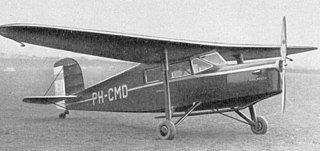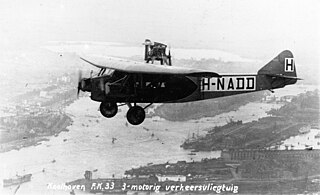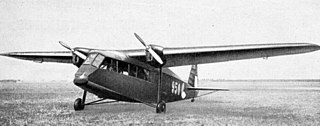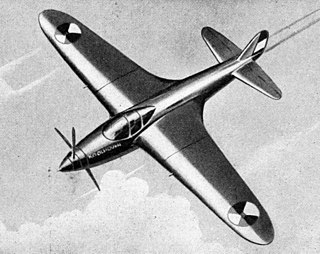
The Koolhoven F.K.58 was a single engine, interceptor-fighter aircraft designed and mainly manufactured by N V Koolhoven in the Netherlands under contract by France. Intended for Armée de l'Air use, the F.K.58 saw limited service in the Battle of France.

Koolhoven F.K.52 was a Dutch-designed, two-seat reconnaissance-fighter biplane, which was developed in the 1930s by Koolhoven. The aircraft was equipped with an enclosed cockpit and single-strut landing gear. Only six aircraft were produced. The aircraft saw some service in the Finnish Air Force.

The Heinkel He 50 was a German World War II-era dive bomber, originally designed for the Imperial Japanese Navy. Serving in Luftwaffe prewar dive-bombing units, the He 50 served until almost the end of World War II as a night harassment bomber.

The Armstrong Whitworth F.K.10 was a British two-seat quadruplane fighter aircraft built by Armstrong Whitworth during the First World War. While it was ordered in small numbers for the Royal Flying Corps and Royal Naval Air Service, it was not used operationally. It is one of the few quadruplane aircraft to reach production.

The BAT F.K.23 Bantam was a British single-seat fighter biplane produced by British Aerial Transport Company Limited of London during World War I.

The BAT F.K.26 was a British single-engined four-passenger biplane transport aircraft produced by British Aerial Transport Company Limited of London at the end of World War I.

The BAT F.K.28 Crow was a British single-seat ultralight aircraft produced by British Aerial Transport Company Limited of London. It was intended to be the "aerial equivalent of the motor cycle".

The Koolhoven F.K.43 was a small four-seat, single-engined monoplane passenger aircraft manufactured by Koolhoven in the Netherlands. It was a direct successor of the F.K.41.

The Koolhoven F.K.51 was a 1930s Dutch two-seat basic training biplane built by the Koolhoven Company.

The Koolhoven F.K.42 was a parasol-wing, two-seat training monoplane manufactured by Koolhoven in the Netherlands. Only one was built.

The NVI F.K.33 was an airliner built in the Netherlands in 1925 for use by KLM for night flying.
The Koolhoven F.K.40 was a small airliner built in the Netherlands in 1928 for KLM Royal Dutch Airlines. It was a conventional high-wing cantilever monoplane powered by a single engine in the nose. The fuselage was made of welded steel tube construction with a wooden wing skinned in plywood and held in place by four bolts to facilitate removal. The cabin was spacious for an aircraft of its size, and was intended to be readily reconfigured for passengers, mail, or freight. Although up to six seats could be fitted, the only F.K.40 built flew with four.

The Koolhoven F.K.49 was a photographic survey aircraft built in the Netherlands in 1935.

The Koolhoven F.K.53 Junior was a small sport aircraft built in the Netherlands in 1936. It was a low-wing cantilever monoplane of conventional design, with tandem seating for two under a long canopy. The wings had a gull shape and carried the main units of the tailwheel undercarriage. Two examples were built, and both destroyed in the German bombing of Waalhaven in May 1940. The first machine built had been purchased by the Dutch national flying school.

The Koolhoven F.K.55 was a Dutch fighter prototype of the 1930s, which did not progress beyond the prototype stage.

The Koolhoven F.K.56 was a 1930s Dutch basic training monoplane designed and built by Koolhoven.
The Koolhoven F.K.57 was a twin-engined, gull-winged monoplane built in the Netherlands as a personal transport for the Director General of Royal Dutch Shell. Only one was made, flying chiefly in Europe in the year before World War II, but destroyed when Germany invaded the Netherlands in May 1940.
The Koolhoven F.K.44 was a two-seat, single engine sport monoplane designed and built in the Netherlands in the early 1930s. It was built to order, but only one was completed.

The Koolhoven F.K.54 was a Dutch single-engine, three-seat touring aircraft with a retractable undercarriage. It flew shortly before the start of World War II and its development was abandoned after its first flight as attention turned to military aircraft.

The NVI F.K.35 or Koolhoven F.K.35 was a two-seat fighter aircraft built in the Netherlands during 1926. It was completed and exhibited but, through a combination of ground accident and financial problems, never flown.


















